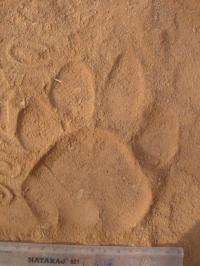Paw prints and feces offer new hope for saving tigers

As experts gather in St Petersburg, Russia for next week's Tiger Summit, fewer than 3,200 tigers survive in the wild worldwide. More than half live in India, where they are spread over a vast area (100,000 sq km) of forest.
According to Dr Yadvendradev Jhala of the Wildlife Institute of India, lead author of the new study: "Tigers are cryptic, nocturnal and occur at low densities so they are extremely difficult to monitor. Unless we know how many tigers are left in the wild, and whether their numbers are increasing or decreasing, we will not be able to conserve them."
Until now, tiger numbers have been monitored either by their paw prints (known as pugmarks) or by using camera traps. Although wildlife agencies use paw prints to identify individual animals, scientists regard this as an inaccurate way of monitoring tiger numbers. And while camera trap mark-recapture is reliable, it requires highly-trained personnel and is so expensive and labour intensive that it cannot be widely used.

In search of a low-cost, scientifically-robust monitoring method, Dr Jhala and colleagues worked at 21 different sites in the forests of Central and North India collecting two tiger signs– paw prints and faeces. "Tiger faeces are the size of large beetroot and have a characteristic pungent, musky odour. Fresh tiger faeces are normally accompanied by urine sprays that smell like well-cooked basmati rice," Dr Jhala explains.
When they compared this data with that from camera traps at the same sites, they found they could estimate tiger numbers as accurately by using the two tiger signs – paw prints and faeces – as they could with camera traps, but for a fraction of the price. For each site, it cost US$1,240 and took 220 person-days to collect data on paw prints and faeces, compared with US$17,000 and 720 person-days for camera trapping.

The results have crucial implications for conserving tigers and other endangered species worldwide. "By showing that it is possible to accurately estimate tiger numbers from their paw prints and faeces, we have opened up a new way of cost-effectively keeping our finger on the pulse of tiger populations and gauging the success of conservation programmes. This approach could be applied to monitoring other endangered species across vast landscapes," Dr Jhala says.
More information: Yadvendradev Jhala et al (2010), 'Can the abundance of tigers be assessed from their signs?', doi:10.1111/j.1365-2664.2010.01901.x , is published in the Journal of Applied Ecology on 19 November 2010.
Provided by Wiley












